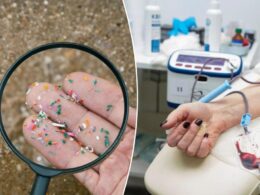A few weekends ago, I was posed with a challenge that made me clutch my zillennial pearls: a request from my editors to lock my phone away for 72 hours.
Having grown up with the first generation that hardly remembers life without cellphones (and yes, I know that many people who didn’t will roll their eyes), like most late-20-somethings I know, I treat my phone as nothing less than a bonus appendage: a home-office, social hub, finance tracker and news desk rolled into one pocket-sized digital partner that I rarely leave home without.
Though I’ve never given a hoot about carrying the latest model (my inner circle knows I’d gladly use my dinged-up iPhone 12 ‘til the end of time, should Apple permit), using a smartphone has become a necessity in carrying out my day-to-day tasks.
Not to mention a lifeline to contact friends and family, post pics, peruse Amazon and watch stand-up comedy reels on Instagram.
My assignment would be to give up my device cold turkey for three full days.
I would rediscover what it’s like to live in the world phone-free and communicate with others sans screens — if such a task would even be possible in this hyper-digital age.
Initially, I panicked: It’s Halloweekend! I have plans! How the hell do I navigate New York City without my phone?!’
But I reminded myself that this was not entirely uncharted territory.
Neo-Luddism — once normal life for folks about 30 years ago but now a growing movement of people who passively avoid technology, actively oppose it, or sit somewhere in the middle — is on the rise.
Though the club is unofficial per se, organized groups like Kanso Digital Wellness and The Reconnect Movement (which don’t explicitly classify themselves neo-Luddite but share many of the same principles) are popping up across the nation with phone-free events and experiences.
These groups take a skeptical approach to the heavy societal reliance on modern tech, acknowledging its necessity while aiming to improve our relationship with it. The meet-ups also create environments where the focus is on face-to-face connection.
Tiffany Ng, a 24-year-old writer who runs the Substack newsletter Cyber Celibate and whose August experiment of chaining her phone against a wall for a week garnered 1.8 million views on Instagram, fancies herself a neo-Luddite.
“I know that word is very intimidating to some people, and that it can be seen as hypocritical sometimes,” Ng told me. “I’m calling myself this, and yet I have an Instagram account. But there’s a spectrum … I love the term ‘neo-Luddite’ because it’s encouraging (people) to have conversations on what it means to scale back on technology and be more mindful with our consumption.”
Airbnb founder Brian Chesky maintains that our current consumption habits — which often include the irresistible itch to check personal devices at work — have gotten out of hand.
When he recently asked underlings to identify issues within the company, people checking phones and laptops in meetings was mentioned, The Wall Street Journal reported.
“These things are tools. They’re neither good or bad, inherently — it’s what we do with them,” Chesky said. “Overuse is an issue. I don’t think the phone is a problem. I think the amount of time we stare at a phone is a problem.”
To address my own phone overuse, I decided to bite the proverbial bullet and take my editors up on this no-phone challenge with my own neo-Luddite experiment.
After defining the perimeters — phone away at midnight, laptop use solely for work purposes — and a few hours of prep, I did the zillenial version of the unthinkable: I turned my phone off.
Here’s how those days went.
Day 0: Friday, Oct 31
5 p.m. to 12 a.m.: Seven hours pre-experiment
Turns out, there are some significant logistics to consider before locking up one’s phone and throwing away the key.
First, I pulled up Apple Maps to determine exactly how I would get to my friend Dylan’s “Boo! I’m Almost 30” birthday/Halloween celebration Saturday night in the East Village.
I’m no expert at navigating the Big Apple, even with my iPhone, having only moved here six months ago, so this was definitely the task that worried me most when staring down the barrel at this experiment.
After jotting down train directions — with no apps available, Uber would be out — I texted my date, Gene, and arranged to meet him at the Trader Joe’s outside the First Avenue subway station on Saturday at 8:15 p.m. I prayed we’d both be on time and wouldn’t miss each other!
I posted across social platforms that I’d be off the grid for 72 hours straight, to little fanfare — though my best friend called and said she’d “see (me) on the other side.”
Next, I dug out the Garmin running watch I’d used just twice before deeming it too complicated (ironically, not a technology girl). I’d need it to keep track of time — no more glancing down at my phone screen for a quick check! I disabled smart notifications to keep the experiment as pure as possible.
Once all the prep work was done, it was about 11 p.m. Over the next hour, I plopped on the couch, turned on “Selling Sunset” (my new favorite comfort-reality show), and partook in one last tech hurrah: a mindless scroll-through of my phone.
As I toggled between apps, swiping past endless posts and videos from friends, friends-of-friends and creators, I felt a niggling sense of anxiety.
Just how reliant had I become on this palm-sized device?
When the midnight hour cutoff finally came, I squeezed the side buttons of my iPhone to turn it off. The screen’s quick cut to black felt vaguely ceremonious.
I worried I would have trouble sleeping without my regularly scheduled small screen time, but ended up having the best night of sleep I’d had in months.
Day 1: Saturday, Nov. 1
Halloween/birthday party
First thing in the morning, I reached for my bedside charger to unplug my device, only to remember I had put it in “phone jail” — a.k.a., the dish rack — the night before. Already, I was annoyed. How would I get through the entire experiment without one of my favorite ways to decompress?
Later, I visited a few drugstores in search of disposable cameras, as I wanted to take photos at Dylan’s party and thought it would be fun to capture memories in an old-school way. The CVS a few blocks away ended up having them for $22.79, though the college-aged employee looked at me funny when I asked for one.
I worked for a while when I came home — and without the usual barrage of notifications and texts as distractions, it was remarkable how my ability to concentrate skyrocketed.
When it came time to leave for the party, I donned my homemade costume — a personification of the phrase “Holy guacamole!” — complete with green turtleneck, avocado sticker and sparkling halo. I looked in the mirror and, for a split second, felt genuinely sad that I wouldn’t be able to post it on Instagram.
Then I laughed out loud at the absurdity of it all.
Almost immediately after leaving my apartment, my Garmin glitched and stopped working. On the train, I asked a man for a time check, followed by a lovely young couple. They were the only people looking up — everyone else was buried in their social media feeds.
Gene and I managed to find each other at the Trader Joe’s entrance without a hitch and made our way to Dylan’s apartment. Ironically, there was a conspicuous lack of phone usage that night — I was struck by how wonderful it was to be among people talking, laughing and connecting IRL.
As a natural introvert, it was nerve-wracking not having the option to retreat to my phone if my social anxiety ramped up. But with such good company, the feeling shortly dissipated. It felt empowering to realize I didn’t need that virtual crutch to have a good time.
Throughout the night, I told a few people about my experiment. The most common response was: “In New York? That’s crazy!” The more we spoke, however, I realized that this effort to squash screen time in favor of real human connection was a battle many of my peers were fighting daily — to varying degrees of success.
“I’ve been trying to reduce my phone time, in general, but especially when I’m around other people,” Ramandeep Rekhi, a 30-year-old clinical scientist with Stanford University and a new friend I met at the gathering, shared a few days later. “I try to actually spend time with them and not stare at a screen the whole time.”
The rest of the night was a solid 10 — even without the opportunity to impress my meager Instagram following with my punny costume.
Who’da thought?
Days 2 and 3: Sunday, Nov. 2, to Monday, Nov. 3
A changing mindset
Though researchers at the University of South Australia recently found it takes about two months to change a habit, according to a study published in the journal Healthcare, I noticed some key shifts in my behavior regarding phone usage (or lack thereof) over the next two days of the experiment.
My parents visited the city to see me on Sunday, so I broke my work-only laptop rule to coordinate brunch over email. As we ate our meal together and caught up on life, I felt fewer of the “phantom pings” that had been plaguing me to check my palm for a device that was no longer there.
I even went to the restroom without reaching to bring my phone first!
As cliché as it may sound, I also noticed myself eating more slowly, as well as feeling more present as I enjoyed my food and, later, our breezy walk through Brooklyn’s Prospect Park. I felt refreshed and alert, even with it being the last day of Daylight Saving Time.
However, Monday was a case of one step forward, two steps back.
I’d initially had plans for a hair appointment and to work on some projects, but woke up with a bad headache and canceled most of my plans for the day.
As I moped around the apartment and half-heartedly attempted to separate my dirty clothes — I couldn’t use the washer/dryer since my building’s utilities require a laundry app — I found myself craving a scrolling sesh.
I stared longingly at my phone in its makeshift prison — did it miss me as much as I missed it? — but managed to stay strong.
I’d like to say that I didn’t practically pounce on my device like a lustful cartoon lover with pop-out eyes when 12 a.m. rolled around.
But I can’t.
Alas, this journey was not perfect, and neither is this writer.
Still, experiment complete!
Conclusion
According to Randy Ginsburg, 28, the founder of Kanso Digital Wellness, it made sense that I started to feel physically and mentally better on the second day of the experiment, even with my small setback on the third.
“I’d imagine you were a little more creative, less stressed and more productive,” Ginsburg told me when we spoke about my experience (I adamantly agreed).
Ginsburg regularly speaks to folks of all ages who are seeking to repair their relationship with technology so that it serves them — not the other way around.
“It’s about introducing you to meaningful people who will hopefully become core pieces of your social fabric, so you can spend more time doing fun things that improve your life — rather than scrolling in isolation.”
While I’m not sure I will ever go another 72 hours completely phone-free, I have integrated some neo-Luddite principles into my life since the end of this experiment.
When I’m with friends, I now make a conscious effort to keep my device in my pocket, rather than glued to my palm. I’ve also gotten better at keeping it in another room during my personal writing time. Those ‘phantom pings’ still go off sometimes, but they’ve become far less successful at grabbing my time and attention.
Though I still can’t say I’d ever go full-on neo-Luddite — I’m not some zillenial saint, after all — this experience reminded me of a cross-generational truth: that the real world is way larger (and more fun) than an iPhone screen.








